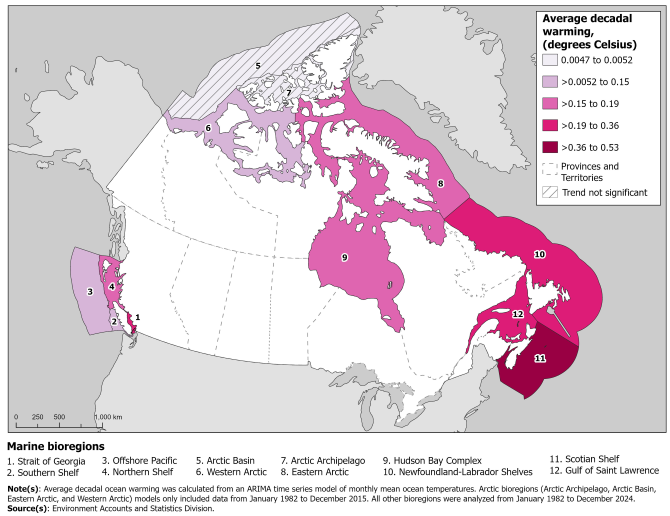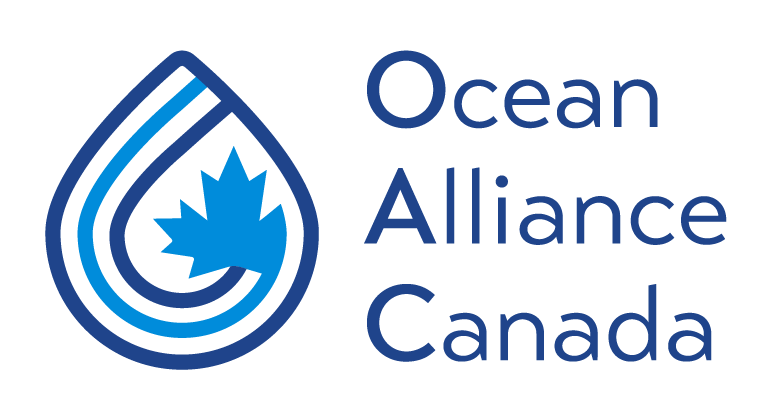A Changing Ocean, A Changing Reality
By: Yogendra Chaudhry, Chair – Ocean Alliance Canada (OAC)
Canada’s oceans are warming – and the impacts are rippling across our Blue Economy. According to the Census of Environment: Ocean Condition Account, recently released by Statistics Canada, every one of Canada’s marine bioregions has experienced consistent warming since 1982. Regions like the Scotian Shelf and the Strait of Georgia have seen the highest increases in sea surface temperature, posing growing risks to marine ecosystems and the industries that depend on them.
These aren’t just environmental data points – they’re warning signs of economic volatility, ecosystem disruption, and climate pressure for sectors like fisheries, aquaculture, shipping, and marine tourism.
As we reflect on these findings, one thing becomes clear: Canada must prepare for a warmer ocean future together.
Key Findings: Ocean Temperature and Ecosystem Trends
Sea surface temperature increases (1982-2023):
Scotian Shelf: +0.53 °C per decade
Strait of Georgia: +0.36 °C per decade
Newfoundland-Labrador Shelves: +0.33 °C per decade
Gulf of St. Lawrence: +0.33 °C per decade
Phytoplankton productivity (Chlorophyll-a & POC):
The Strait of Georgia shows the highest concentrations – essential for fish stocks and marine carbon cycling.
Other regions show seasonal instability, signaling deeper ecological shifts.
Together, these data points suggest rising stress on Canada’s ocean ecosystems, with downstream effects on the climate resilience of Blue Economy industries.

Source: Statistics Canada, 2025. Sea Surface Temperature Anomalies, 2023. Census of Environment: Ocean Condition Account. Link
“This data from Statistics Canada is both a wake-up call and a roadmap. It tells us that the future of Canada’s Blue Economy depends on our ability to work together across sectors, regions, and worldviews to respond to our changing oceans with urgency and innovation.”
Dr. Yogendra Chaudhry (Yogi), Chair, Ocean Alliance Canada
What This Means for Canada’s Blue Economy
This isn’t just a climate science update – it’s a strategic warning for Canada’s future in the Blue Economy.
Here’s what the ocean data tells us:
Fisheries and aquaculture operators will face more uncertainty as marine life cycles shift.
Ocean technology companies must lead in monitoring, modeling, and adaptive innovations.
Policymakers and Indigenous leaders must use this data to guide community-based adaptation and equitable planning.
Ocean workforce development needs to evolve rapidly – building capacity in data science, climate modeling, and marine resource stewardship.
The Role of Ocean Alliance Canada
At Ocean Alliance Canada (OAC), we see this moment as both a challenge and an opportunity. OAC was launched by ECO Canada to unite stakeholders across industry, government, academia, and Indigenous communities – ensuring Canada’s Blue Economy is climate-smart, inclusive, and future-ready.
We’re committed to:
Amplifying marine ecosystem intelligence
Supporting industry-led innovation
Building resilient ocean careers and talent pipelines
Hosting collaborative spaces to shape national strategy
Join the Conversation
Help shape Canada’s response to ocean change:
Become a member of Ocean Alliance Canada
Join our Working Groups on climate resilience, ocean data, and sustainable marine industries
Attend upcoming OAC events and roundtables
Subscribe to stay informed on Canada’s Blue Economy
Together, we can build a thriving ocean economy that is both sustainable and resilient.
Explore the Ocean Data
Read the full report:
Statistics Canada – Census of Environment: Ocean Condition Account (June 17, 2025)
Share this article on social media.



